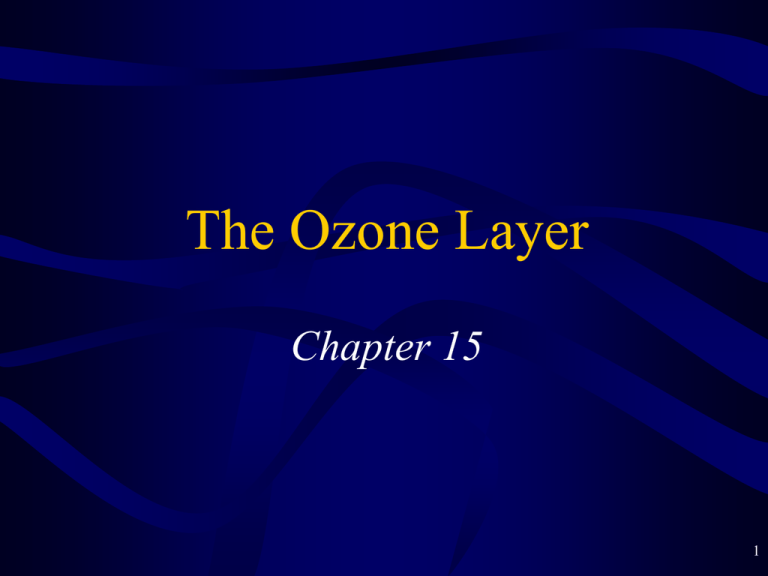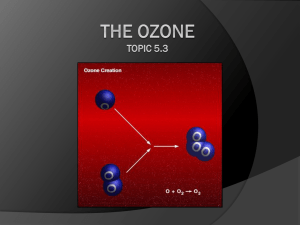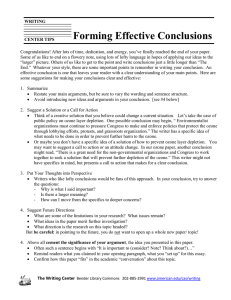The Ozone Layer Chapter 15 1
advertisement

The Ozone Layer Chapter 15 1 Good Ozone • The ozone layer = 15-30 km altitude in stratosphere – Photochemical smog is ozone in the wrong place • Earth’s Natural Sunscreen: blocks ultraviolet light • Ozone is only a small fraction of the gases – N2, O2 are still the majority of the gases in ozone layer – O3 would make a 3.5 mm thick layer at Earth’s surface • Ozone is produced at the tropics, flows to poles 2 Layers of the Atmosphere 3 Antarctic Ozone Hole • Ozone totals are measured in “Dobson Units” – 350 Dobson Units is typical in temperate regions – Ozone levels have decreased below 150 Dobson Units over Antarctica • Began to occur in late 1970’s – Levels are lowest in Antarctica’s Spring (Sept—Nov) – Normal levels regained by June—July – Geographic Region effected is growing each year • Not really a hole; more like a thinner window 4 Seasonal Ozone Fluctuations in the N. Hemisphere 5 Average October Ozone Levels over Antarctica 6 Extent of the Arctic Ozone Hole 7 Cause of the Ozone Hole • Chlorine Pollution has been proven as the cause • CFC’s = Chlorofluorocarbons – One of the main sources of atmospheric chlorine – Used as refrigerants in air conditioners and refrigerators • Fairly unreactive, so they make it to ozone layer • Laws have greatly reduced chlorine pollutions • We will probably still have ozone hole until ~2050 8 Molecules and Light • The spectrum – Visible light: 400—750 nm (ROYGBIV = rainbow) – Color changes as wavelength changes – Ultraviolet light = UV = 50—400 nm (invisible) • More energetic than visible light • Energy increases as wavelength decreases • Molecules can interact with visible and UV light – – – – Absorption Spectrum = graph of light absorbed vs wavelength Light absorption increases the energy of the molecule Bonds can be broken or new bonds formed O2, as all molecules do, absorbs light selectively 9 A portion of the electromagnetic spectrum O2 absorption spectrum in UV 10 Ozone absorbs UV light • O2 absorbs all UV between 120—220 nm – Above the stratosphere • UV between 50—120 nm is absorbed by N2, O2 • O3 vital because it absorbs 220—320 nm UV – UV-C = 220—280 nm O3 + O2 remove all – UV-B = 280—320 nm O3 absorbs 70-90% • Depends on season, latitude, etc… • Never completely successful • Fraction of UV-B escaping increases as wavelength increases – UV-A = 320—400 nm is not stopped by any gases • Least harmful type of UV light 11 Ozone’s Absorption Spectrum 12 Biology and the Ozone Layer • UV-B does escape the ozone layer – – – – 1% loss in ozone = 2% increase in UV-B on the ground Causes sunburn, cataracts, and skin cancer Affects immune system Affects the growth of plants and animals • DNA absorbs UV-B and is damaged – Replication of new DNA, cells goes wrong = cancer – Skin cancer is most common, since it gets most sun • Loss of ozone is predicted to cause increase in skin cancer • Slow spreading form; can be detected and treated • 25% of Americans will have some form in their lifetimes 13 UV light damage to DNA 14 Malignant Melanoma • Fatal form of skin cancer – – – – 1 in 100 Americans will likely get it Short, high UV exposure early in life linked to it Fair skin, fair hair, freckles makes you susceptible 15-25 year lag time between exposure and melanoma • Likely only seen the tip of the iceberg • Skin cancer cases are expected to rise (1970’s + 25 = 2000) – Incidence of melanoma based on several things • Latitude: Texas and Florida have higher rates • Lifestyle: Australia has higher rates 15 Sunscreens • Substances that block UV light on your skin – Some only block UV-B, not UV-A • Don’t get burned, but can still damage your skin, DNA – How they work • Reflect all light = ZnO, TiO2; white, inorganic • Absorb UV before it reaches your skin = organic molecules O O O O 4-Methylbenzylidene camphor (4-MBC) Octyl methoxycinnamate (OMC) – Must not break down as they absorb light ----> useless 16 Other Effects of UV • Cataracts – Cornea and Lens filter 99% of UV before it reaches your retina – Chemical reactions cause opaqueness of the lens – Primarily a UV-B caused problem – Usually long-tern; short-term when severe exposure • Effects on Animals and Plants – Photosynthesis by plants reduced when UV-B increases – Oceans depend on surface phytoplankton – Amphibian mortality and deformity 17 Normal Eye Eye with a cataract 18 Ozone Hole Chemistry • Light Energy – Photon = discrete packet of light having a specific energy – Energy of light is inversely related to the wavelength • Infrared = wavelength longer than visible is less energetic • Ultraviolet = wavelength shorter than visible is more energetic • Energy: UV-C > UV-B > UV- A > Visible > Infrared • Photochemical Reaction – Requires light energy to start a chemical reaction – Light must be of exact wavelength/energy required – 500 nm light activated reaction won’t work with 400 nm 19 Creation of Ozone • Ozone formation occurs in the upper stratosphere – UV-C not yet filtered out at this altitude O2 + UV-C ----> 2 O O + O2 ----> O3 + heat • Temperature of stratosphere is warmer than those below – Temperature Inversion (usually cools as you move upward) – Little mixing of the O3 layer that forms 20 Recycling of Ozone • Ozone is destroyed as it filters UV O3 + UV-B/UV-A ----> O2 + O O2 + O ----> O3 (mostly) O3 + O ----> 2 O2 (some) – NO and other gaseous pollutants speed up O3 destruction – O3 “lives” about 30 minutes at 30 km altitude – Formation/Destruction is called the Chapman Cycle – Ozone Layer: < 10 ppm O3 << O2 and N2 21 The Chapman Cycle 22 Chlorine and Ozone • Chlorine initiates ozone destruction Cl + O3 ----> ClO + O2 (chorine monoxide) 2 ClO ----> ClOOCl (dichloroperoxide) ClOOCl ----> ----> ----> 2 Cl + O2 Total: 2 O3 ----> 3 O2 – Cl is a catalyst (speeds up reaction); not used up – Each Cl atom can destroy 50 O3 molecules per day – Bromine (Br) reacts in the same way • Small amount compared to Cl pollution 23 Chlorine Activation • Only Cl, ClO are active ozone destroying Cl forms • Cl is mostly found in inactive form – ClONO2 = chlorine nitrate ClO + NO2 ----> ClONO2 – HCl = hydrogen chloride Cl + CH4 ----> HCl + CH3 • Antarctica’s weather favors active forms – – – – – Dark/cold: PCS = polar stratospheric clouds (ice crystals) Air pressure drops = vortex = whirling cold air is isolated HCl + ClONO2 + PCS ----> Cl2 + HNO3 (dark) Cl2 + light ----> 2 Cl (beginning of spring) Ozone decreases 2% per day until PCS clouds melt 24 Antarctic Seasons and Ozone Levels 25 An Arctic Ozone Hole? • Arctic winters are not as cold as Antarctic ones – Vortex breaks up before light is present to activate Cl • Temperatures are expected to drop in Arctic – 1996 record cold year – Observable “hole” in Arctic Ozone occurred • Chlorine pollution is dropping worldwide – Enough in atmosphere for Arctic Hole for 10-20 years 26 Ozone Decreases in Non-Polar Areas • Worldwide ozone amounts fell about 3% since 1980 – Besides poles, mid-latitudes experienced greatest loss – Decreases usually occur in March—April in N. Hem. • The explanation of this phenomenon is not as clear – Do pollution droplets function like polar PCS clouds? – Volcanoes have given off H2SO4 in these regions • Dilution of Polar air masses definitely contributes 27 Ozone Depleting Chemicals • Sink = natural process to regulate the concentration of a compound: CO2 has vegetation, oceans as a sink • Sources of Chlorine and Bromine – CH3Cl (methyl chloride) produced by decaying plants – CCl4 (carbon tetrachloride) used in dry cleaning – Manmade CFC’s have no sink in nature • Not water soluble • Doesn’t react with most other gases • Not reactive with visible or UV-A light – Drift to stratosphere by natural buoyancy (60 yr lifetime) • CF2Cl2 + UV-C ----> CF2Cl + Cl 28 Chlorine Sources and Levels 29 CFC Replacements • The presence of C—H bonds allows decomposition OH + H—CCl3 ----> H2O + decomposed products – CH3Cl is partially removed before reaching stratosphere • HCFC’s = hydrofluorochlorocarbons – – – – CHF2Cl = HCFC-22 Air conditioners and Refrigerators currently use these Only about 5% of the risk to ozone as CFC’s Temporary bridges to even better compounds • HFC’s = hydrofluorocarbons – FCH2CF3 = HFC-134a already being used 30 Ozone Hole: the success story • International Agreements have limited damage – Rowland/Molina predicted problem in 1970’s (Nobel) – CFC’s banned in Europe by late 1970’s – 1987 Montreal Protocol: phase out of ozone depleters • • • • 1995 all legal CFC production ceased 2010 goal for developing countries Halon = CF3Br, CF2BrCl illegal by 1994 HCFC use to end by 2030—2040 (no increase after 2015) • Future: chlorine pollution will be removed as HCl – Cl peak 1999 – No ozone hole after 2050 31


